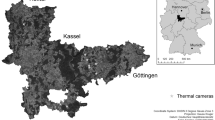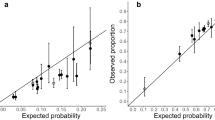Abstract
The growing rate of wildlife underpass use for the mitigation of road-induced wildlife mortality necessitates the development of low-cost monitoring tools for determination of mitigation success. Trail cameras are one such tool that can provide valuable insight into the usage patterns and effectiveness of wildlife underpasses. We deployed trail cameras in wildlife underpasses in Guelph, ON, to develop recommendations for camera monitoring protocols. The trail cameras used high interval time lapse and motion sensors from April to October of 2016 to capture crossing by a variety of species through two slotted, small animal underpasses. Daily and seasonal underpass usage patterns of 21 species and species groups suggest that to comprehensively monitor underpass usage, cameras must be active continuously and utilize high frequency time lapse and motion sensors simultaneously to capture crossing events by both endothermic and ectothermic species. Although these recommendations are dependent on the specific objectives and target conservation species, these results can be used to guide a range of underpass monitoring programs.



Similar content being viewed by others
References
Aresco, M. J. (2005). Mitigation measures to reduce highway mortality of turtles and other herpetofauna at a north Florida lake. Journal of Wildlife Management, 69(2), 549–560.
Ascensão, F., & Mira, A. (2007). Factors affecting culvert use by vertebrates along two stretches of road in southern Portugal. Ecological Research, 22, 57–66.
Baxter-gilbert, J. H., Riley, J. L., Lesbarrères, D., & Litzgus, J. D. (2015). Mitigating reptile road mortality: fence failures compromise ecopassage effectiveness. PLoS One, 10(3), 1–15.
Beebee, T. J. C. (2013). Effects of road mortality and mitigation measures on amphibian populations. Conservation Biology, 27(4), 657–668.
Dodd, C. K., Barichivich, W. J., & Smith, L. L. (2004). Effectiveness of a barrier wall and culverts in reducing wildlife mortality on a heavily traveled highway in Florida. Biological Conservation, 118(5), 619–631.
Ford, A. T., Clevenger, A. P., & Bennett, A. (2009). Comparison of methods of monitoring wildlife crossing-structures on highways. Journal of Wildlife Management, 73(7), 1213–1222.
Forman, R. T. T., & Alexander, L. E. (1998). Roads and their major ecological effects. Annual Review of Ecology and Systematics, 29(1), 207–231.
Glista, D. J., DeVault, T. L., & DeWoody, J. A. (2007). Vertebrate road mortality predominantly impacts amphibians. Herpetological Conservation and Biology, 3(1), 77–87.
Glista, D. J., DeVault, T. L., & DeWoody, J. A. (2009). A review of mitigation measures for reducing wildlife mortality on roadways. Landscape and Urban Planning, 91(1), 1–7.
Lesbarrères, D., & Fahrig, L. (2012). Measures to reduce population fragmentation by roads: what has worked and how do we know? Trends in Ecology & Evolution, 27(7), 374–380.
Lesbarrères, D., Lodé, T., & Merilä, J. (2004). What type of amphibian underpass could reduce road kills? Oryx, 38(2), 220–223.
Malt, J. (2012). Assessing the effectiveness of amphibian mitigation on the sea to sky highway: Population-level effects and best management practices for minimizing highway impacts. Final report. Ministry of forests, lands, and natural resources operations, south coast region, British Columbia, Canada.
Pagnucco, K. S., Paszkowski, C. A., & Scrimgeour, G. J. (2011). Using cameras to monitor underpass use by long-toed salamanders (Ambystoma macrodactylum): an informative, cost-efficient technique. Herpetological Conservation and Biology, 6(2), 277–286.
Pagnucco, K. S., Paszkowski, C. A., & Scrimgeour, G. J. (2012). Characterizing movement patterns and spatio-temporal use of under-road underpasses by long-toed salamanders in Waterton Lakes National Park, Canada. Copeia, 2012(2), 331–340.
Patrick, D. A., Schalk, C. M., Gibbs, J. P., & Woltz, H. W. (2010). Effective culvert placement and design to facilitate passage of amphibians across roads. Journal of Herpetology, 44(4), 618–626.
van der Grift, E. A., van der Ree, R., Fahrig, L., Findlay, S., Houlahan, J., Jaeger, J. A. G., Klar, N., Madrinan, L. F., & Olson, L. (2013). Evaluating the effectiveness of road mitigation measures. Biodiversity and Conservation, 22(2), 425–448.
Welbourne, D. J., Claridge, A. W., Paull, D. J., & Lambert, A. (2016). How do passive infrared triggered camera traps operate and why does it matter? Breaking down common misconceptions. Remote Sensing in Ecology and Conservation, 2(2), 77–83.
Woltz, H. W., Gibbs, J. P., & Ducey, P. K. (2008). Road crossing structures for amphibians and reptiles: informing design through behavioral analysis. Biological Conservation, 141(11), 2745–2750.
Acknowledgements
The authors would like to thank A. McLaren for his technical assistance, as well as S. Hughes, C. Parent, and S. Spitale of North-South Environmental Inc. for their commitment, enthusiasm, and insight.
Author information
Authors and Affiliations
Rights and permissions
About this article
Cite this article
Pomezanski, D., Bennett, L. Developing recommendations for monitoring wildlife underpass usage using trail cameras. Environ Monit Assess 190, 413 (2018). https://doi.org/10.1007/s10661-018-6794-0
Received:
Accepted:
Published:
DOI: https://doi.org/10.1007/s10661-018-6794-0




